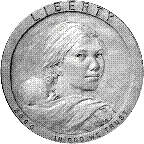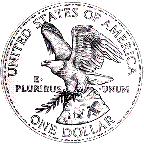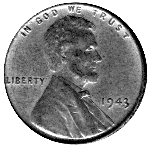

Meeting 7:30pm, Wednesday, January 6
Talk and trading 7:00-7:30pm
VFW, 1601 Weld Road,
Elgin, IL
815-786-6779

 The Commission of Fine Arts recommended these obverse and reverse designs to Secretary of Treasury
Robert Rubin December 17, according to the Coin World. Sculptor Glenna Goodacre designed the obverse and
Mint sculptor-engraver Thomas Rogers, Sr. design the reverse.
The Commission of Fine Arts recommended these obverse and reverse designs to Secretary of Treasury
Robert Rubin December 17, according to the Coin World. Sculptor Glenna Goodacre designed the obverse and
Mint sculptor-engraver Thomas Rogers, Sr. design the reverse.
As of December 27, the Mint's web page showed three obverse finalists and four reverse finalists.
This announcement ended a month and a half that saw the number of finalists go from 121 obverse and reverse designs received by the mint to six obverses and seven reverses still in contention a week ago. According to US Mint Director Philip Diehl, the mint received more than 90,000 emails and "several thousand faxes and letters with the overwhelming majority supporting the Sacagawea design." He didn't mention that they gave no other choice than Sacagawea. One can only guess that the "overwhelming majority" might have been for some Statue of Liberty (or another) design had we been given the opportunity to choose one. But the treasury has decided to be politically correct and choose not only a woman but a Native American, non-European woman. No one even knows what this very necessary and useful member of the Lewis and Clark Expedition looked like. She was used as a shield and guide for a semi- military expedition and now she is being used again as an opportunistic subject for the a coin that would better look forward than backward. Nonetheless, the proposed obverse would make a really nice looking coin, even if the reverse is plain [blah?].
The finalists may still be on the www.usmint.gov site by the time you get this.
Jim Davis has recorded a History Channel program on the Mint and Bureau of Printing and Engraving. We will view this for our January program.
We will also discuss our 1999 programs. We were supposed to do so during the December meeting, but the holiday celebration rightfully took precedence and we left without talking about this important subject. We have filled all months except February, March, April, and September. We would like to have presentations from the members in 1999. Please seriously think about what you can give back to the club in the form of a presentation. Maybe two of you can get together and present something.
President Doug Nelson called the 492nd meeting of the Elgin Coin Club to order around 8:30pm after we has a great Holiday meal.
The minutes were accepted as published.
We voted on and received Forrest Wagner and Alan Hagen as new members of the club. Welcome, Forrest and Alan.
Don did not report the treasury numbers. At least my notes indicate that is the case. If I am wrong, I will give you the numbers next month.
Someone reported that the November 9th Elgin Harold had a generous and fine report on our Oct 25th show.
Before the elections, Don Cerny nominated Jim Clevenger to be president and Jim accepted. Don also tried to nominate Frank Slapinski, but Frank would not accept the nod.
The club overwhelmingly re-elected Doug Nelson as president and unanimously elected the Jennifer Schulze to be secretary for the next two years. Congratulations, Doug and Jenifer, we wish you luck and a fine two years of service.
We had no raffle or door prizes. Instead, each member present got a ticket and we drew for 23 prizes given to the lucky two thirds of those who were there.
Doug closed the meeting around 9:00.
Submitted by Mike Metras
We had no board meeting. It seems there were more pressing things happening than Elgin Coin Club meeting plans. Maybe it was Christmas.
This it the beginning of the sixth year for your Elgin Coin Club Newsletter. Where do I see it going this year? Most of the old things will continue.
Last year the "Coin of the Month" article made every month except the months with the Summer Seminar serial. I want to keep the "Coin of the Month" a monthly happening.
You can see a few changes in the layout this month. Look for more modifications as the year goes on. I had more redesigning planned for the beginning of the year, but December was too busy and I just didn't get to them.
I would like to offer some space in this Newsletter to any other club in the area that would like to put their activities or announcements here. I know that this Newsletter goes out to at least two or three other clubs that do not have any form of newsletter. We have nine regional clubs reading this Newsletter, so if you want me to add something here for the others read, send it to me, whoever you are.
This may turn out to be a bit more of a goal than I can hit, but the farther out I set my target, the farther out I will get, even if I miss the ultimate goal.
 We were in the middle
of the second world war of the century. The war effort need the copper being minted into cents and nickels. The
mint experimented with several things including plastics, ceramics, and several other alloys without copper.
We were in the middle
of the second world war of the century. The war effort need the copper being minted into cents and nickels. The
mint experimented with several things including plastics, ceramics, and several other alloys without copper.
In the end the mint settled on a 2.70 gram, low-carbon steel coin with a 0.0005" coating of zinc, two metals that easily react with each other. This resulted in a coin that went into auto-corrode mode whenever the temperature went up and there was any moisture in the air. It was a pitiful choice for a coin's metal. Nonetheless, we lived with it for a year.
At first, new versions of these white cents were often mistaken for dimes. Breen adds, "numerous accidental strikings on dime planchets made matters worse!"
People called these cents "steelies," "lead pennies," and "zinc cents." The populace just didn't like them because they quickly corroded to the point that they looked like slugs.
Philadelphia made 648 million 1943 cents, Denver 217 million, and San Francisco 191 million. Few survive in gem BU condition because of the way the metals interact with each other. All are very common and go for 15 to 30 cents in fine in the Red Book, which lists an MS65 from Philadelphia for $4, Denver for $4.50, and San Francisco for $10.
Denver made a repunched mint mark with a strong D punched to the south west of the final position of the mint mark. The Red Book lists this at $5 in fine and $70 in MS65. In 1988 Breen listed this variety as "presently rare."
At various times since they were minted, commercial ventures have stripped the zinc from corroded cents and replated them, giving them a bright, unnatural look. With a glass, you can easily see the underlaying corrosion, and even ware on poorer examples. These were sold in the '50s, '60s, and '70s as "reprocessed" 1943 steel cents. I haven't seen them on the market in the recent years. To me as altered coins, they have little or no numismatic value.
The mint was lax in many of its practices in those days. Several bronze planchets were left over at the end of 1942. They were probably left in the cent press supply hopper and mixed with the new steel planchets resulting in an unknown number of 1943 cents on bronze planchets originating in the mint. In Breen in his 1988 book says about 40 are known from Philadelphia, about 6 from San Francisco, and about 24 from Denver.
You say you have a 1943 bronze cent? You must get it authenticated. Breen lists the following four tests that every candidate must pass:
In 1965 the mint actually issued press releases denying the genuineness of any 1943 bronze cent because, as stated in one case, "The Mint Makes no mistakes."
So if there are 1943 bronze cents, are there 1944 steel cents? Yes, and for the same reason as there are 1943 bronzes--a few 1943 steel planchets were left over at the end of 1942. As the year before, the steel planchets were probably left in the cent press supply hopper and mixed with the new 1944 planchets resulting in an unknown number of 1944 cents on steel planchets originating in the mint. Breen says that number is considerably smaller than the off- metal 1943s.
Philadelphia was also making a zinc-coated steel 2 franc coin for Belgium in 1944. It was so close to the same weight (2.75 grams) as the cent that, with the lax quality control, some of these planchets could have also accidently mixed with the bronze 1944 planchets resulting in steel 1944 cents.
As with the off- metal 1943s, these 1944 steel cents must be authenticated. Any that exist would be of a very weak strike since the dies would not have come together enough to have given them a good strike.
And after all that, this steel cent made its appearance in a great year and month--the same year and month I made my current appearance.
Breen. Walter Breen's Complete Encyclopedia of U.S. and Colonial Coins. Doubleday, 1988. New York.
R.S. Yeoman. K. Bressett, ed. A Guide Book of United States Coins. Western Publishing, 1966. Racine, WI.
Visit the Elgin Coin Club Home Page or our Connections page for more information about the club.
Click here for an index to articles in other on-line Elgin Coin Club NewslettersThis Newsletter is the informal mouthpiece of the Elgin Coin Club. This Newsletter and its contents are copyrighted but you may use anything herein (accept as noted below) for non-commercial use as long as you give credit to the Elgin Coin Club Newsletter. This blanket permission does not extend to articles specifically marked as copyrighted (c) by the author of the article. In the latter case, you must get explicit written permission from the author either directly or through the Newsletter to use that material.